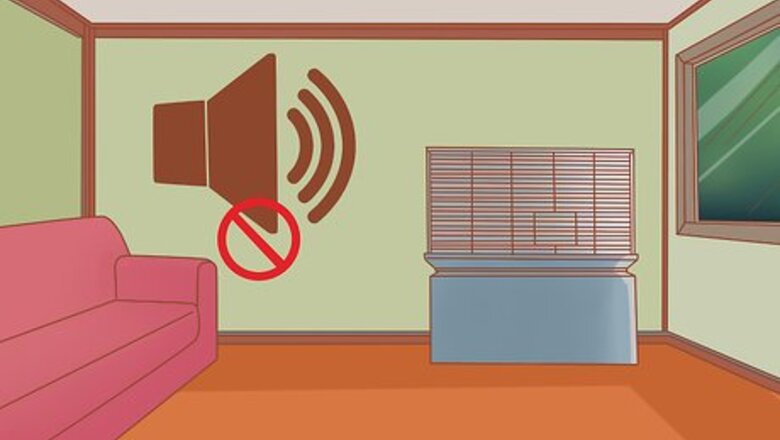
views
Getting To Know Your Parakeet
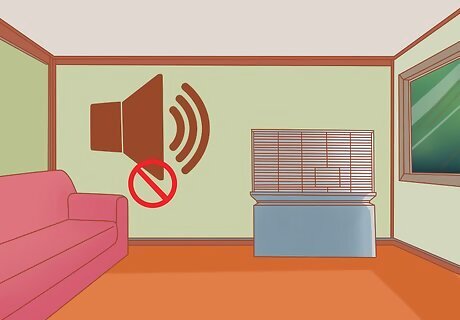
Make your budgie comfortable. The cage is a safe space for your parakeet, but you want him or her to be in the presence of your family enough to be used to seeing and hearing people. Be sure, however, that this is a place where the bird can get rest when wanted—budgies need 10-12 hours of sleep per night. Cover the cage when your budgie sleeps—this blocks his or her vision and keeps drafts at bay—and be sure no loud noises will startle your parakeet where it's sleeping
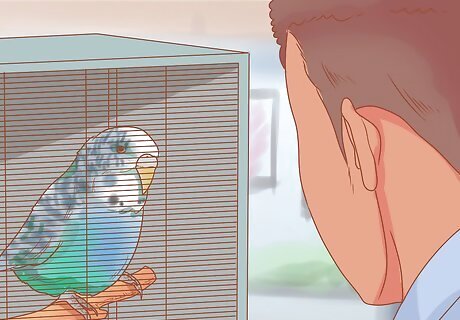
Get closer to your budgie. Once the bird seems comfortable in his or her cage where you have put it—and especially where they will be in the presence of people on a regular basis—start getting closer to the cage each day. Move slowly when you come near the cage so as not to frighten your parakeet. Talk softly to the bird when you are near the cage. Avoid sudden movements. Spend plenty of time near the cage—the more the better. Your parakeet will know that you know he or she is there. You are essentially the bird's flock, with which he or she would spend all their time with in the wild, so the more time you spend with your budgie, the better.
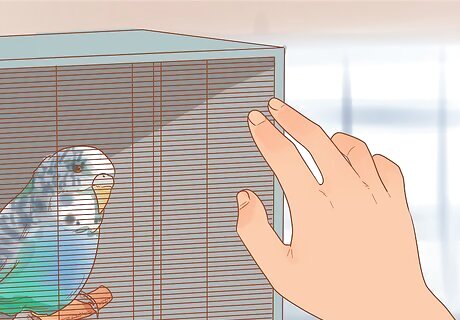
Start putting your hand on or near the cage near the bird gently. If it moves away, don't move your hand; instead, keep it there and talk to the bird or read a book. The point is to get the bird used to your hand and your presence. Be sure not to scare the bird.
Hand Training Your Budgie
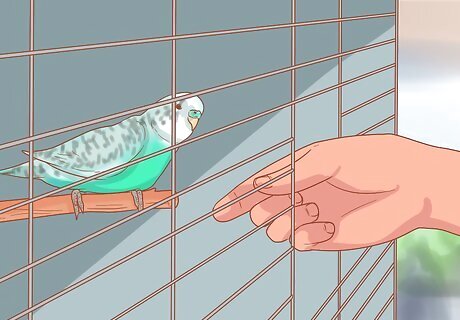
Approach your budgie from inside the cage. Once your parakeet doesn't move away from your hand, it's time to do the same on the inside of the cage. Reach inside your budgie's cage and rest your hand there for a while. It's especially effective if you do this while holding a treat, such as millet. Holding a treat helps to gain the bird's trust. Slowly, over time, move your hand closer and closer to your bird. Chances are, if you are holding a treat, your parakeet will begin to eat from your hand. If you coax your budgie to a place in the cage where he or she cannot reach the treat in your hand while on a perch or the side of the cage, your budgie will likely be convinced to jump onto your hand to get the treat.
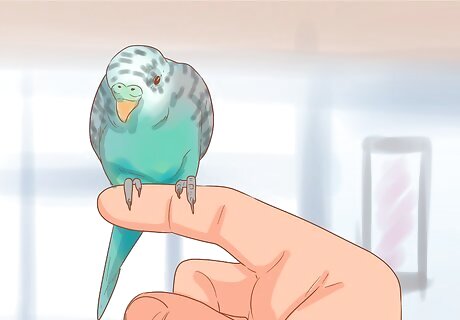
Get your parakeet to perch on your finger. After a while of feeding the bird on/from your hand, try to get your budgie to perch on your finger without food by slowly approaching it with your finger and nudging it against their belly near the feet. Your parakeet may jump off your finger quickly, but keep trying—just don't overwhelm the bird. Give him or her some time between attempts and continue to move slowly. Be patient, and your bird should start getting on your finger voluntarily over time.
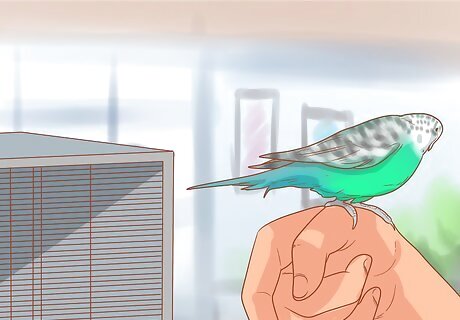
Bring your budgie out of its cage. The next phase of hand training is getting your bird to come outside the cage while perched on your hand. Because your parakeet feels safe inside the cage, he or she may jump off your hand near the exit. Keep trying, though, just like when you tried to get him or her to eat from your hand or perch on your finger. Eventually your budgie will learn to trust you enough to come outside the cage with you.
Interacting With Your Parakeet
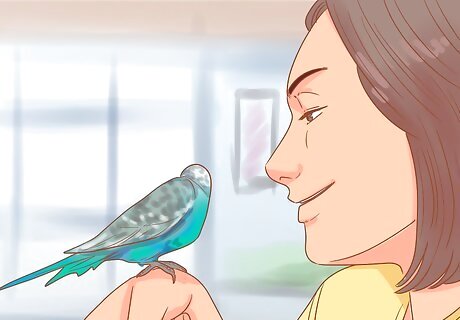
Talk to your parakeet a lot. Every time you pass by your parakeet, stop a minute and talk to it. If you repeat the same phrases or noises (such as whistles) when you do talk to your bird, he or she may even start saying them him or herself. Parakeets can talk just like other pet birds. Talking to the bird also gets him to trust you more—which can translate to a loving budgie.
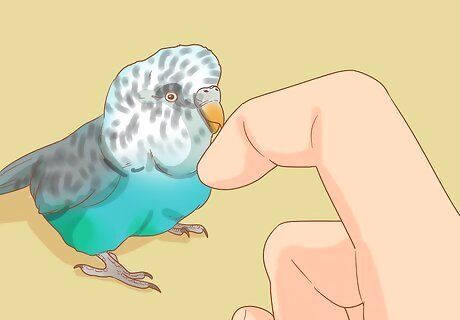
Try petting your parakeet. Parakeets may occasionally groom one another, and, as you are part of their flock, your budgie may like it if you gently rub or stroke his or her feathers in different places. Try scratching his or her head very gently, stroking his or her back, or rubbing his or her belly.
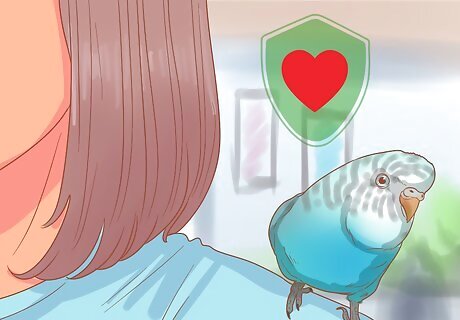
Remember to always handle your parakeet with care. Budgies are small and very delicate. Take it easy when handling your budgie and you will have an even more trusting pet, which can translate to a loving relationship with your bird. Never hit or do anything rough with your parakeet. Never kiss your budgie on the beak or anywhere else, because human saliva, even in small concentrations, is toxic for a budgie. Parakeets may take time to warm up to you. "My parakeet was very afraid of me, but with these helpful tips he's warming up and isn't backing away from my hand. I can't wait until he can perch on my finger!" - Jason D. A cage mate made all the difference. "We got our little guy, Oscar, a year ago. He was very skittish and would not be handled. We decided to get him a cage mate. Since the new addition, he has not hidden from us or even attempted to hide in his burrow. Our new little girl is just what Oscar needed to bring him out of his shell. We hope he becomes even more accepting." - Kat K. Have a story our readers should hear? Share it with 1 billion+ annual wikiHow users. Tell us your story here.
Caring for Your Parakeet
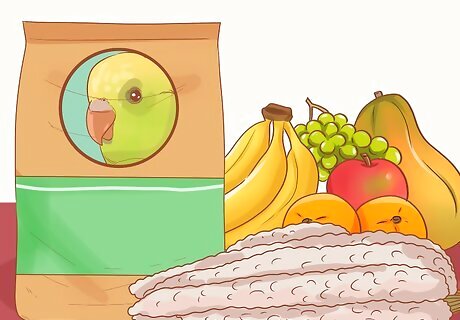
Feed your budgie a variety of foods, like fruits and vegetables, seeds and pellets. A full bird is a happy bird, particularly when it isn't bored of the food you give it. Give your budgie seeds, pellets, fruits and vegetables. Start out with natural pellets that contain no colorings or added sugar. Feed seeds separately—not mixed with pellets. There are some foods to avoid, including avocados, eggplant, mushrooms, onions, chocolate and more.
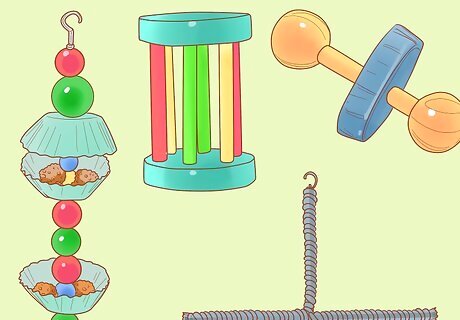
Give your parakeet plenty of toys. Parakeets play a lot, so toys will keep them very happy, making them more loving pets. Give them shiny toys, swings, rings, bells, etc.
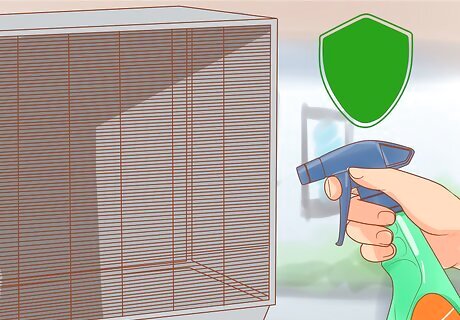
Keep your budgie's cage clean. Budgies appreciate a clean home just like people. The difference is that budgies live in close proximity to their droppings. Keeping their cage clean minimizes exposure and helps keeps your bird nice and healthy. Get good perches for your parakeet(s). Perches with varying diameter like natural tree branches help your budgie get exercise that is in addition to you bringing him or her out of the cage.

















Comments
0 comment